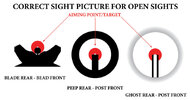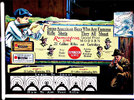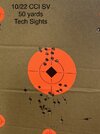Matthew Clark
Member
Hello whom ever thought to look in on this post. Let me say first I am not trying to be a smarty pants here. I know there are situations where the sights legitimately do not match. However there are some folks, and I have met many at the local range, that honestly just don't know how to use basic sights correctly.
In this age of technologically advanced optics, fewer and fewer people actually use basic sights. So when faced with the situation that they have to use basic sights they run into trouble. As with anything, if not taught how to do something correctly, we struggle with operation and our desired outcomes are often never realized or we waste immeasurable time with trial and error till we finally get satisfaction.
My purpose here is to educate those who are struggling and have not recieved any instruction. Or just don't know where to get it. The fact that I hear more and more folks on gun blogs struggling with guns printing high with the rear sight all the way down, I find it hard to believe that that many firearms are so mismatched and let go from the factory with factory installed peep sights especially.
So, here is a picture of a few different types of basic sights and the corresponding sight picture you should be utilizing. Good ole iron sights are relatively easy to align but point of aim seems to be difficult for some. With peep sights, a few people make it way harder than it really is.
When you look through the aperture your eye will automatically center in the picture. If done correctly you don't even see the rear sight, maybe a slight haze ring. Concentrat on the front bead or blade only and put it at 6:00 of the intended POI. A good cheek to stock weld point is important here. You may find you have preferences for a brass bead, blade or post front sight but the basics are the same. You can even adjust field of view with different sized apertures. Your precision will increase with a smaller aperture and getting on target with running game will be faster with all the way up to ghost ring rear apertures.
When you have mastered the peep sight, it will rival your ability with a scoped gun out to 100yds or more. Camp Perry shooters shoot a long ways out with peep sights. Anyway I hope this will help someone who is struggling. That's all I intend to do with this. If you disagree with my statements by all means put it out there. Your thoughts might help someone better than what I had to say.
Note where the little white dot above the post or bead is located. When properly adjusted, that is where the bullet will strike. If you are still having issues, then a new front sight will have to be installed most likely. Printing high will require a taller front sight.
Remember to move the rear sight in the direction you want the bullet to go. Front sights are the opposite, you move the front sight in the opposite direction. If you should have questions please ask. I will do my best to answer you.
Happy shooting!
Matthew
In this age of technologically advanced optics, fewer and fewer people actually use basic sights. So when faced with the situation that they have to use basic sights they run into trouble. As with anything, if not taught how to do something correctly, we struggle with operation and our desired outcomes are often never realized or we waste immeasurable time with trial and error till we finally get satisfaction.
My purpose here is to educate those who are struggling and have not recieved any instruction. Or just don't know where to get it. The fact that I hear more and more folks on gun blogs struggling with guns printing high with the rear sight all the way down, I find it hard to believe that that many firearms are so mismatched and let go from the factory with factory installed peep sights especially.
So, here is a picture of a few different types of basic sights and the corresponding sight picture you should be utilizing. Good ole iron sights are relatively easy to align but point of aim seems to be difficult for some. With peep sights, a few people make it way harder than it really is.
When you look through the aperture your eye will automatically center in the picture. If done correctly you don't even see the rear sight, maybe a slight haze ring. Concentrat on the front bead or blade only and put it at 6:00 of the intended POI. A good cheek to stock weld point is important here. You may find you have preferences for a brass bead, blade or post front sight but the basics are the same. You can even adjust field of view with different sized apertures. Your precision will increase with a smaller aperture and getting on target with running game will be faster with all the way up to ghost ring rear apertures.
When you have mastered the peep sight, it will rival your ability with a scoped gun out to 100yds or more. Camp Perry shooters shoot a long ways out with peep sights. Anyway I hope this will help someone who is struggling. That's all I intend to do with this. If you disagree with my statements by all means put it out there. Your thoughts might help someone better than what I had to say.

Note where the little white dot above the post or bead is located. When properly adjusted, that is where the bullet will strike. If you are still having issues, then a new front sight will have to be installed most likely. Printing high will require a taller front sight.
Remember to move the rear sight in the direction you want the bullet to go. Front sights are the opposite, you move the front sight in the opposite direction. If you should have questions please ask. I will do my best to answer you.
Happy shooting!
Matthew





